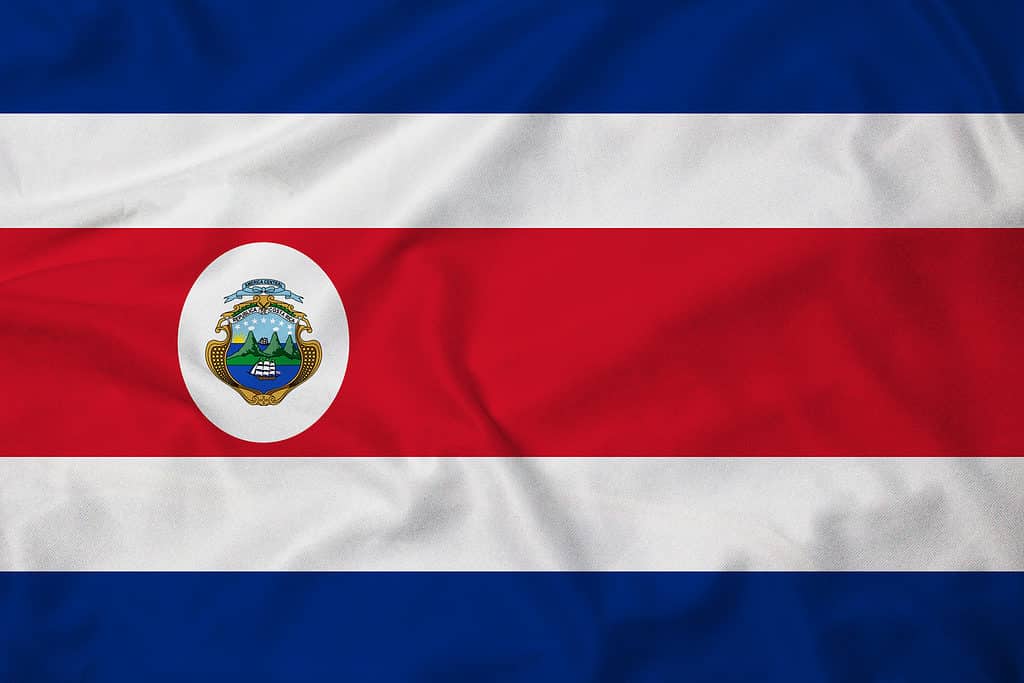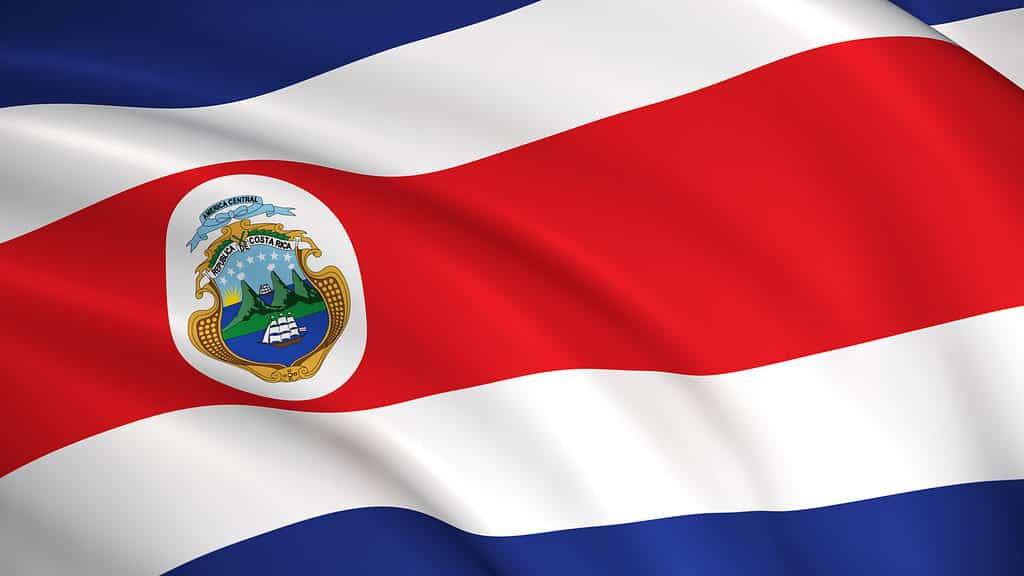The Costa Rican flag and shield serve as powerful symbols for the country’s history and development. These are not commonly thought-about connotations, but they can help us comprehend better how and why Costa Rica and its inhabitants became what they are today. For example, did you know that the flag of Costa Rica is based on an illustration from 1848?
The flag was altered seven times during the brief era of 1821 to 1848. It then adopted its present design in 1848, with a few minor changes made subsequently. This flag has a lengthy history and a special significance that uniquely marks Costa Rica. Today, we are going to explore this flag’s history, meaning, and symbolism!
Flag of Costa Rica History

The current flag of Costa Rica has 5 horizontal stripes in blue, white, red, white, and blue with the current coat of arms off-center to the left of the red stripe.
©Creative Photo Corner/Shutterstock.com
Up Until 1823
Costa Rica was the southern province of the Captaincy General of Guatemala during the majority of its colonial history. Although this province legally belonged to the Viceroyalty of New Spain (i.e., Mexico), it largely ran on its own inside the Spanish Empire. As a result, until 1823, the numerous flags of the Spanish Empire were flown over what is now Costa Rica.
1823 – 1841
Formerly known as the “United Provinces of Central America,” the Federal Republic of Central America was a sovereign state that included the old Captaincy General of Guatemala’s territory. This state included Costa Rica as a component. From July 1823 to 1841, Costa Rica flew the flag of the United Provinces of Central America, which was based on the Argentine flag. It was modified to include information specific to the State of Costa Rica of the United Provinces of Central America. This included the Costa Rican State Seal superimposed, in blue and white stripes.
1848
After the Federal Republic of Central America was unofficially dissolved in 1841, Costa Rica adopted the Central American flag as its model. President José Mara Castro Madriz’s wife, Pacifica Fernández Oreamuno, proposed a new arrangement on September 29, 1848, and it was approved. She suggested adding a red stripe to the flag as a show of solidarity for the 1848 revolution in France. Since that time, the customary flag has been in use.
1900s
The coat of arms of the government has been somewhat altered over time, including in 1906, 1934, 1964, and 1998. However, the overall design of the flag has remained the same.
The Costa Rican Coat of Arms’ Evolution and History

The current flag of Costa Rica has been in use since 1848, with slight modifications being made to its coat of arms.
©Royal Graphics/Shutterstock.com
The history and evolution of the existing shield or coat of arms are surprisingly comparable to the flag. It was modified five times before the 1848 design. The Coat of Arms, which eventually underwent changes to become the symbol for the United Provinces of Central America, was initially shaped by five volcanoes. The right arm and naked chest of a man were depicted in this sign, which was surrounded by a ring of green mountains.
The design before the current one, used until 1848, had a white star with eight points and a yellow circle. It had the legend of Costa Rica inscribed around it. The 1848 model contained two ships, five stars, and three volcanoes. This has since been altered aesthetically, but most closely resembles the current emblem. It was slightly changed in 1906, 1964, and 1998. It now has two additional stars and smoking volcanoes.
Flag of Costa Rica Meaning
Design
Two blue, two white, and two more white stripes around a core red stripe that is twice as broad as each of the other four stripes make up the design of the flag. The version flown by the government has the coat of arms as well. The ratio of its length to width is 3 to 5.
Colors
The Costa Rican flag features the colors red, white, and blue. These are widely seen on various flags around the world and are also known as the “colors of liberty.” They frequently stand in for victory in the struggle for independence and emancipation. In actuality, 29 nations fly a red, white, and blue flag!
Flag of Costa Rica Symbolism

The flag of Costa Rica represents many things such as peace, knowledge, joy, and independence.
©MotionEmo/Shutterstock.com
The colors of the flag stand for liberty, equality, and solidarity. They are the original emblems of the 1848 French Revolution. The sky represents possibilities within reach, persistence in reaching a goal, eternity, and the values of one’s spiritual ambitions. White is a symbol of the happiness, knowledge, joy, and peace of Costa Rica. The warmth of Costa Ricans, their love of life, their struggle for independence, and their generous nature are all represented by the color red.
The coat of arms holds significant symbolism for Costa Rica as well. The three smoking volcanoes on the sign reflect the three main volcanic ranges of Costa Rica: Irazu, Poas, and Arenal. Second, the green area beneath the volcanoes represents the valley that lies in the middle of the mountain ranges. Third, the oceans stand in for the Pacific and Atlantic oceans, while the ports along either side of Costa Rica are symbolized by the ships. The seven stars on the coat of arms represent the seven provinces of the republic which are: Alajuela, Cartago, Guanacaste, Heredia, Limon, Puntarenas, and San Jose.
Up Next:
- Red Flag with Yellow Star: Vietnam Flag History, Meaning, and Symbolism
- The Flag of Greenland: History, Meaning, and Symbolism
- The Flag of Uganda: History, Meaning, and Symbolism
The photo featured at the top of this post is © titoOnz/Shutterstock.com
Sources
- Wikipedia, Available here: https://en.wikipedia.org/wiki/Flag_of_Costa_Rica
- Britannica, Available here: https://www.britannica.com/topic/flag-of-Costa-Rica
- Costa Rica.org, Available here: https://costarica.org/facts/flag/
Thank you for reading! Have some feedback for us? Contact the AZ Animals editorial team.






